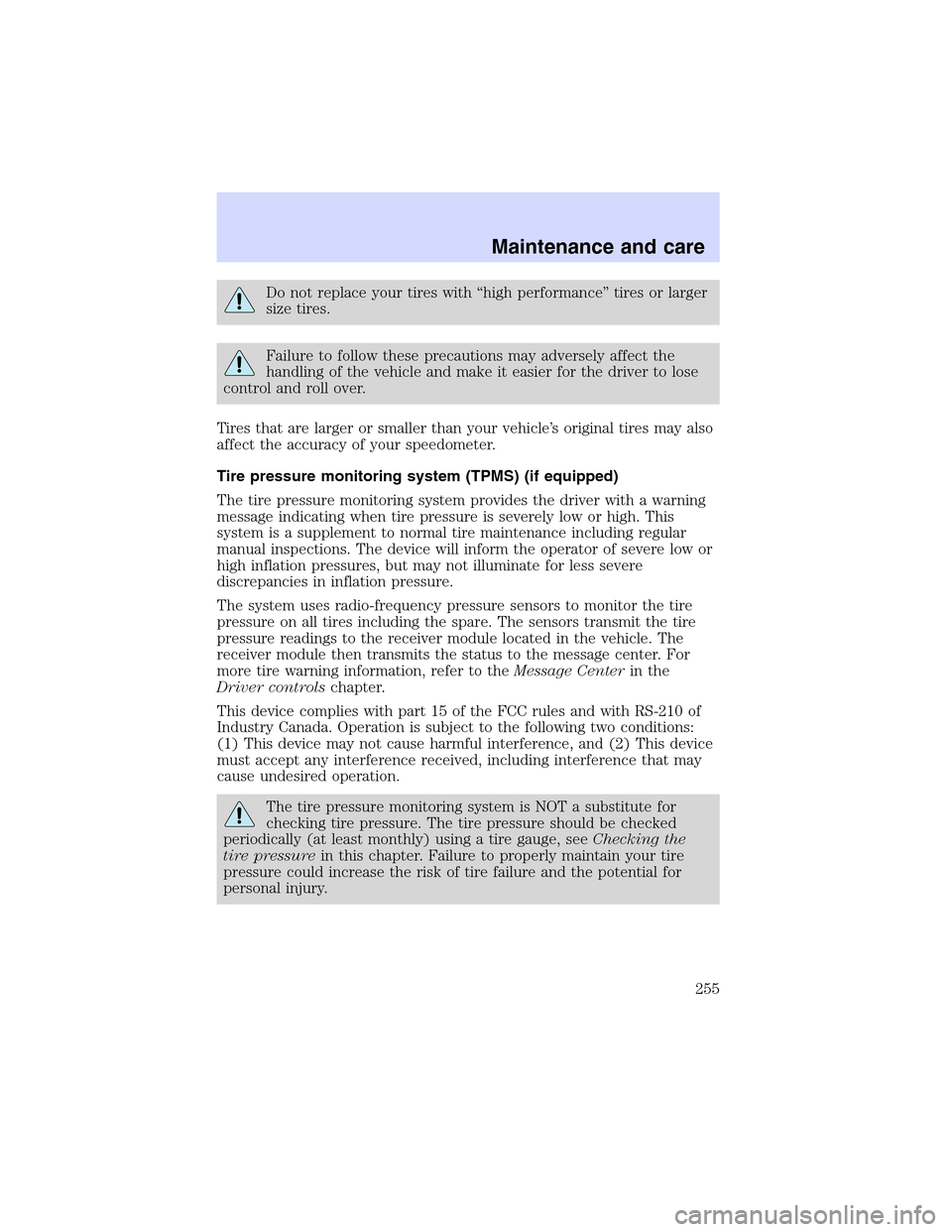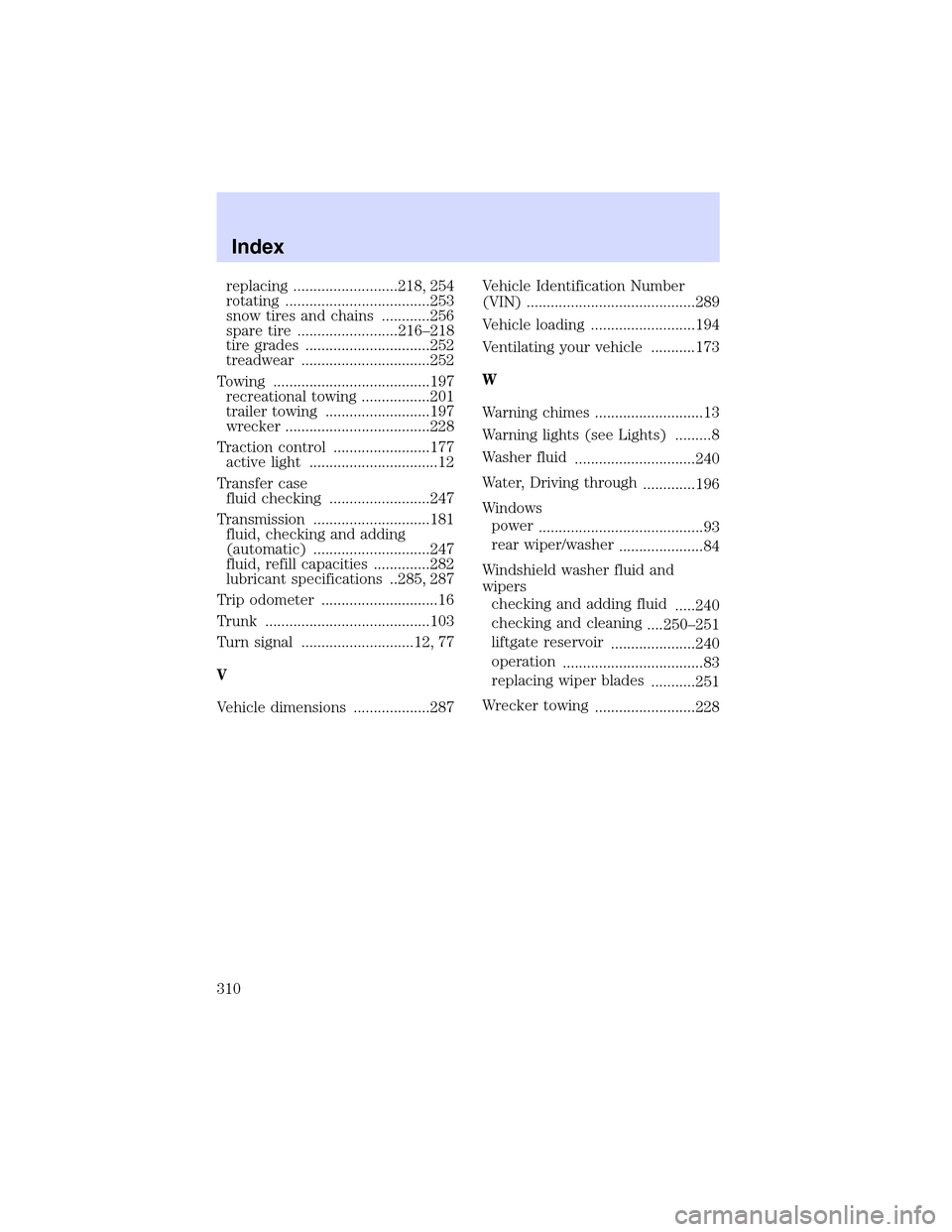spare tire Mercury Mountaineer 2002 s User Guide
[x] Cancel search | Manufacturer: MERCURY, Model Year: 2002, Model line: Mountaineer, Model: Mercury Mountaineer 2002Pages: 312, PDF Size: 3.02 MB
Page 253 of 312

SERVICING YOUR TIRES
Checking the tire pressure
•Use an accurate tire pressure gauge.
•Check the tire pressure when tires arecold,after the vehicle has
been parked for at least 3 hours or has been driven less than 5 km (3
miles). As you drive, the temperature in the tire warms up, increasing
the tire pressure.
•Adjust tire pressure to recommended specifications found on the
Certification Label. Tire pressure information can also be found on the
Tire Information label located on the inside of the fuel filler door.
•Check tires for proper air pressure monthly. Check spare tire for
proper air pressure every six months.
Improperly inflated tires can affect vehicle handling and can fail
suddenly, possibly resulting in loss of vehicle control.
Tire rotation
Because your vehicle’s tires perform different jobs, they often wear
differently. To make sure your tires wear evenly and last longer, rotate
them as indicated in the scheduled maintenance guide. If you notice that
the tires wear unevenly, have them checked.
•Four tire rotation
Maintenance and care
253
Page 255 of 312

Do not replace your tires with“high performance”tires or larger
size tires.
Failure to follow these precautions may adversely affect the
handling of the vehicle and make it easier for the driver to lose
control and roll over.
Tires that are larger or smaller than your vehicle’s original tires may also
affect the accuracy of your speedometer.
Tire pressure monitoring system (TPMS) (if equipped)
The tire pressure monitoring system provides the driver with a warning
message indicating when tire pressure is severely low or high. This
system is a supplement to normal tire maintenance including regular
manual inspections. The device will inform the operator of severe low or
high inflation pressures, but may not illuminate for less severe
discrepancies in inflation pressure.
The system uses radio-frequency pressure sensors to monitor the tire
pressure on all tires including the spare. The sensors transmit the tire
pressure readings to the receiver module located in the vehicle. The
receiver module then transmits the status to the message center. For
more tire warning information, refer to theMessage Centerin the
Driver controlschapter.
This device complies with part 15 of the FCC rules and with RS-210 of
Industry Canada. Operation is subject to the following two conditions:
(1) This device may not cause harmful interference, and (2) This device
must accept any interference received, including interference that may
cause undesired operation.
The tire pressure monitoring system is NOT a substitute for
checking tire pressure. The tire pressure should be checked
periodically (at least monthly) using a tire gauge, seeChecking the
tire pressurein this chapter. Failure to properly maintain your tire
pressure could increase the risk of tire failure and the potential for
personal injury.
Maintenance and care
255
Page 310 of 312

replacing ..........................218, 254
rotating ....................................253
snow tires and chains ............256
spare tire .........................216–218
tire grades ...............................252
treadwear ................................252
Towing .......................................197
recreational towing .................201
trailer towing ..........................197
wrecker ....................................228
Traction control ........................177
active light ................................12
Transfer case
fluid checking .........................247
Transmission .............................181
fluid, checking and adding
(automatic) .............................247
fluid, refill capacities ..............282
lubricant specifications ..285, 287
Trip odometer .............................16
Trunk .........................................103
Turn signal ............................12, 77
V
Vehicle dimensions ...................287Vehicle Identification Number
(VIN) ..........................................289
Vehicle loading ..........................194
Ventilating your vehicle ...........173
W
Warning chimes ...........................13
Warning lights (see Lights) .........8
Washer fluid
..............................240
Water, Driving through
.............196
Windows
power
.........................................93
rear wiper/washer
.....................84
Windshield washer fluid and
wipers
checking and adding fluid
.....240
checking and cleaning
....250–251
liftgate reservoir
.....................240
operation
...................................83
replacing wiper blades
...........251
Wrecker towing
.........................228
Index
310